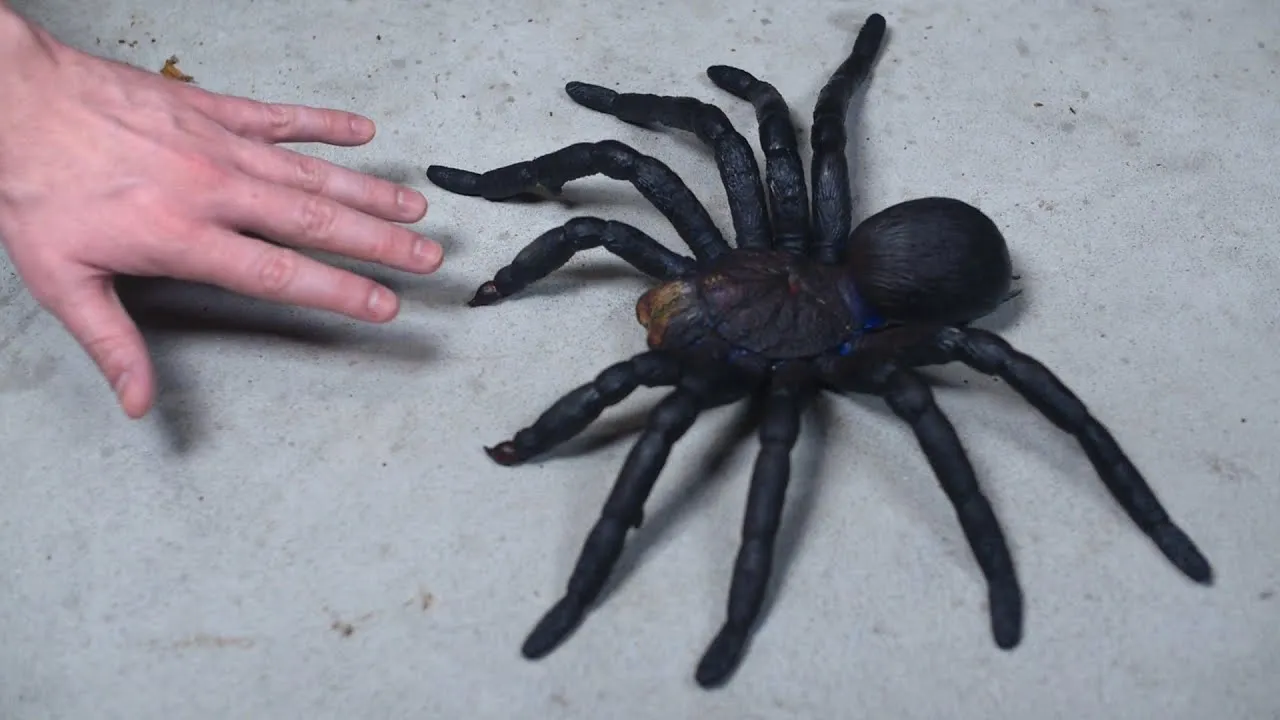What Defines an Old World Tarantula
Old World tarantulas are a captivating group of spiders, and understanding what distinguishes them is key to appreciating their unique characteristics. These arachnids are primarily categorized based on their geographic origins, specifically originating from regions in Africa, Asia, and Australia. This geographical separation from New World tarantulas, which are found in the Americas, results in distinct evolutionary paths and physical adaptations. While both groups share similarities, such as their large size and venomous nature, Old World tarantulas possess specific traits that set them apart, including generally more potent venom and a lack of urticating hairs, relying instead on other defense mechanisms. They showcase an incredible diversity of colors, sizes, and behaviors, making them a fascinating subject of study and a popular, though often challenging, choice for tarantula enthusiasts.
Geographic Origins
As mentioned before, the geographic origin is the fundamental factor in identifying an Old World tarantula. This group hails from continents like Africa, Asia, and Australia, with a wide range of species adapted to various climates and habitats. This diversity in their native environments has contributed to the evolution of unique characteristics among different species, influencing their size, coloration, and behavior. From the dense rainforests of Southeast Asia to the arid landscapes of Africa, Old World tarantulas have carved out their niches. The distribution of these spiders highlights the impact of geographical isolation and the role of environmental pressures in driving species diversification. The distinct habitats where they thrive have further shaped their defensive strategies, hunting techniques, and overall lifestyles, adding to the intrigue surrounding these remarkable creatures.
Distinguishing Features
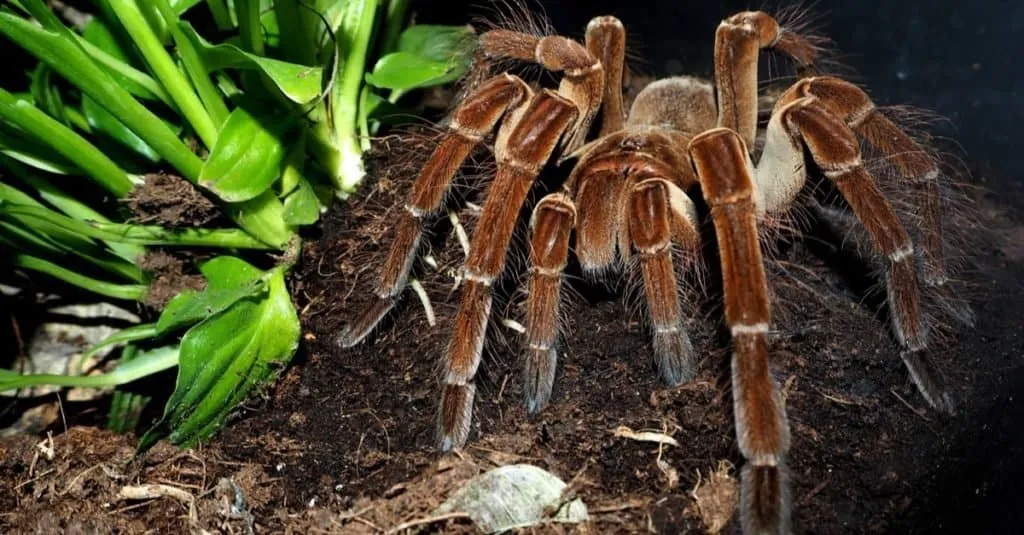
Beyond their geographic origins, Old World tarantulas can be identified by several key features. One of the most significant distinctions is the absence of urticating hairs. New World tarantulas possess these hairs on their abdomen, which they flick towards potential threats as a defense mechanism. Old World tarantulas, however, lack these hairs and instead rely on other defensive strategies. This often includes more potent venom and a tendency to be more aggressive. Another key difference is the structure of their pedipalps and fangs. Old World tarantulas generally have shorter, stouter fangs compared to New World tarantulas. This is an adaptation to their hunting methods, where they often ambush prey. These unique physical attributes, coupled with their behavioral characteristics, contribute to their distinct identity within the tarantula family.
Size and Dimensions
The sheer size of some Old World tarantulas is one of their most awe-inspiring traits. Many species are among the largest spiders in the world, boasting impressive leg spans and body lengths. Understanding how to measure and compare these dimensions helps in appreciating the scale of these arachnids. The size of a tarantula is usually described by its leg span, which is measured from the tip of one leg to the tip of the opposite leg on the same side of the body. Body length, on the other hand, refers to the measurement of the spider’s cephalothorax (the combined head and thorax) and abdomen. The largest species can have leg spans exceeding 10 inches, making them truly remarkable creatures.
Overall Size Comparison
When comparing the size of different Old World tarantulas, it’s important to consider both their leg span and body length. While leg span gives a good indication of their overall size, body length offers insight into the proportion of their body. The Goliath birdeater (Theraphosa blondi) is often cited as the largest spider by weight, although others may have a greater leg span. Species like the Asian giant tarantula (Haplopelma hainanum) are known for their substantial body length, making them appear even more imposing. These size comparisons highlight the amazing diversity within the group and the adaptations that enable these spiders to thrive in various habitats. Different species have evolved to fill specific ecological niches, leading to a fascinating range of body sizes and proportions.
Leg Span vs. Body Length

The relationship between leg span and body length provides valuable insights into the overall morphology of Old World tarantulas. A spider with a large leg span and a relatively short body length may have a more sprawling posture, designed for quick bursts of speed and ground-dwelling. Conversely, species with a more proportionate body length might have a more compact build, ideal for burrowing or climbing. Examining these measurements helps understand how a tarantula’s body plan reflects its lifestyle and environment. The length of the fangs, the size of the chelicerae (mouthparts), and the presence of specialized hairs on their legs can all influence these proportions, underscoring the intricate relationships between form and function in these arachnids. This comparison adds another layer of appreciation for the complex adaptations that have shaped the evolution of these remarkable creatures.
Top 10 Largest Old World Tarantulas
1. Theraphosa blondi (Goliath Birdeater)
The Goliath birdeater, or Theraphosa blondi, is often considered the largest spider in the world by weight and is a prime example of an Old World tarantula. Native to the rainforests of South America, it has a leg span that can exceed 12 inches (30 cm), and a weight that can reach over 6 ounces (170 grams). Despite its name, it rarely eats birds, though it is capable of taking down small mammals, insects, and reptiles. The Goliath birdeater is known for its impressive fangs, which can be over an inch long. Their size and hunting prowess make them a fascinating subject for study.
2. Heteroscodra maculata (Tanzanian Mustard Baboon)
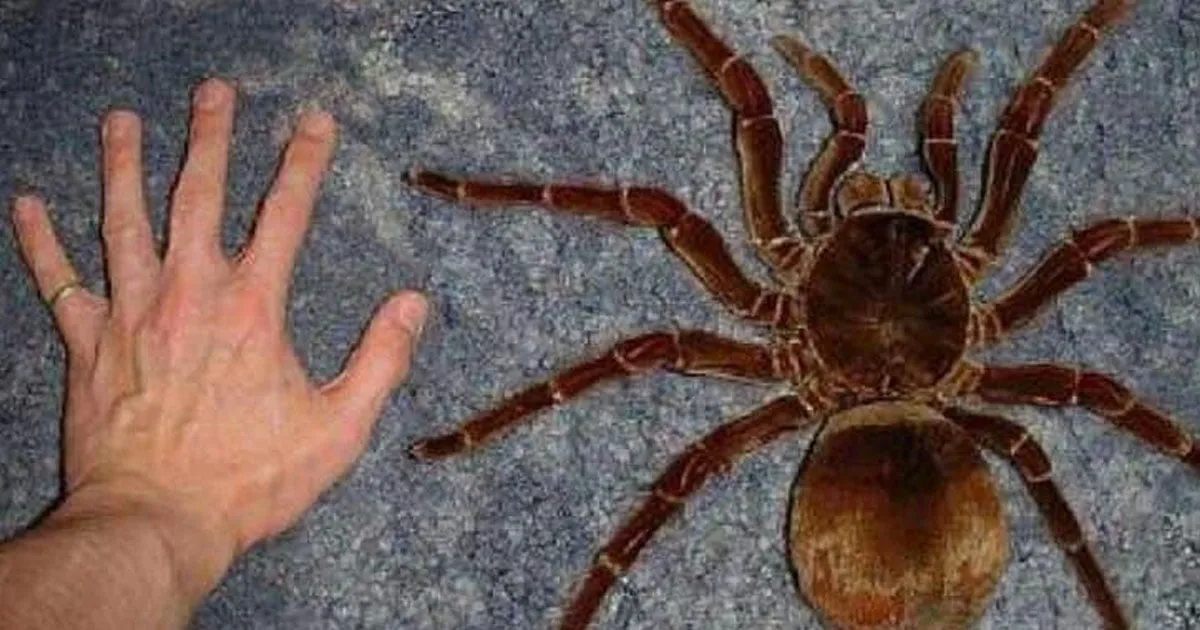
The Tanzanian Mustard Baboon is another large and striking Old World tarantula, characterized by its aggressive nature and vibrant coloration. Its carapace is typically a mustard yellow color, with legs that are a combination of brown and yellow. Native to Tanzania, this species has a leg span that can reach up to 8 inches (20 cm), making it one of the larger African tarantulas. Their potent venom and defensive behavior make them a challenging but rewarding species for experienced keepers. Their speed and agility, coupled with their potent venom, allows them to secure their meals and escape predators.
3. Psalmopoeus irminia (Venezuelan Sun Tiger)
The Venezuelan Sun Tiger, or Psalmopoeus irminia, is known for its beautiful pattern of orange and black stripes. This arboreal (tree-dwelling) tarantula originates from Venezuela. With a leg span that can reach about 6 inches (15 cm), it is a medium-sized but visually stunning spider. It’s known for its generally docile temperament compared to other Old World species, which makes it a popular choice among tarantula enthusiasts. They are quick, agile, and enjoy creating elaborate webs.
4. Poecilotheria regalis (Indian Ornamental Tarantula)
The Indian Ornamental Tarantula, Poecilotheria regalis, is renowned for its intricate and mesmerizing patterns, featuring black, white, and yellow markings. Native to the forests of India, this arboreal species has a leg span of up to 10 inches (25 cm). Its potent venom and fast movements make it a tarantula that requires careful handling. They are popular in the pet trade, appreciated for their beauty, but they are only recommended for experienced keepers. They create intricate web structures where they ambush their prey.
5. Haplopelma hainanum (Chinese Bird Spider)
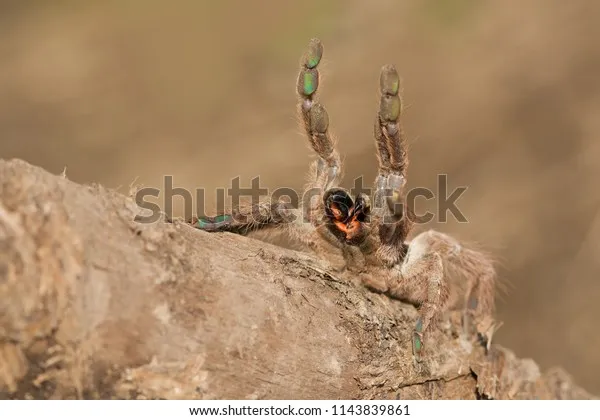
The Chinese Bird Spider, Haplopelma hainanum, is a large and robust Old World tarantula with a generally more reserved temperament compared to other species. Native to Hainan Island, China, it is a burrowing species and has a leg span of up to 8 inches (20 cm). They are appreciated for their size and powerful build, often choosing to hide within their burrows. Like most Old World tarantulas, it’s crucial to approach this spider with caution, as they can be defensive when threatened. Their sturdy bodies and impressive fangs are well-suited for their ambush predator lifestyle.
6. Cyriopagopus albostriatus (Thai Zebra Tarantula)
The Thai Zebra Tarantula, Cyriopagopus albostriatus, gets its name from the distinct zebra-like stripes on its legs. Native to Thailand and Myanmar, this species is a medium-sized Old World tarantula with a leg span of up to 7 inches (18 cm). They are known for their relatively docile temperament and are moderately popular in the pet trade. This species is a terrestrial, or ground-dwelling, tarantula that prefers to burrow. It is a good option for those who are looking for a less aggressive Old World species. Its eye-catching pattern makes it a favorite among tarantula enthusiasts.
7. Omothymus violaceopes (Singapore Blue)
The Singapore Blue tarantula, Omothymus violaceopes, is named for the beautiful blue coloration on its legs and carapace. This arboreal species from Singapore has a leg span of up to 7 inches (18 cm). It is prized for its striking appearance and is moderately aggressive. Despite the stunning colors, these tarantulas are quite defensive. They thrive in humid conditions and create elaborate webs in their arboreal habitats. The Singapore Blue’s beauty and active lifestyle make it an interesting spider.
8. Chilobrachys dyscolus (Asian Fawn)

Chilobrachys dyscolus, often referred to as the Asian Fawn tarantula, is known for its distinctive brown coloration. Native to Southeast Asia, this species is a burrower and can have a leg span of up to 6 inches (15 cm). The Asian Fawn is generally considered to be defensive and is best handled with care, as they can have a defensive strike. They do well in terrestrial setups and are popular in the tarantula hobby, although they are only recommended for experienced keepers. Their camouflaged coloration allows them to blend in with their surroundings.
9. Ornithoctonus aureotibialis (Thai Golden Fringe)
The Thai Golden Fringe, Ornithoctonus aureotibialis, is characterized by the beautiful gold-colored hairs on its legs. This species is found in Thailand and is an arboreal species with a leg span of up to 6 inches (15 cm). They create webs in their arboreal habitat. The Thai Golden Fringe is known for being fast and defensive, and thus, is best handled by experienced keepers. Their vivid coloration and active behavior add to their appeal in the tarantula hobby.
10. Typhochlaena seladonia (Brazilian Jewel)
The Brazilian Jewel, Typhochlaena seladonia, is the final entry, known for its stunning iridescent colors. Found in Brazil, it is an arboreal species and has a leg span of up to 3 inches (8 cm). While smaller than many other Old World tarantulas, this species is known for its beauty and the intricate webs it creates. They are not generally aggressive, but should still be handled with caution. The Brazilian Jewel provides a striking example of the beauty and diversity found within the Old World tarantula family.
Habitat and Behavior
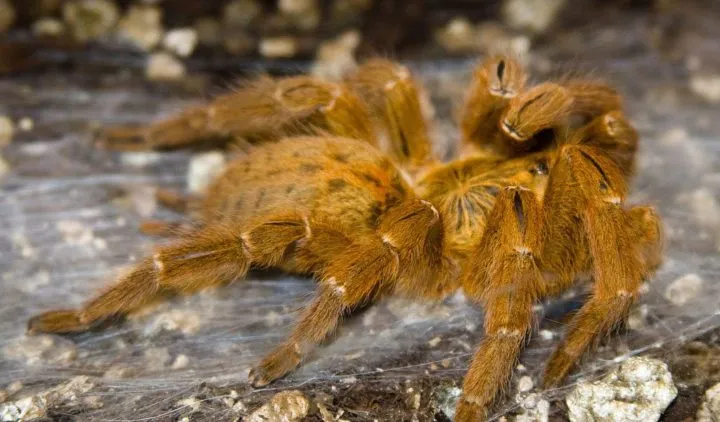
The natural habitats and behaviors of Old World tarantulas are as diverse as the species themselves. Understanding their preferred environments and behavioral traits is crucial for appreciating these creatures and providing appropriate care in captivity. Their adaptations to different habitats highlight their resilience and their role in their ecosystems. These spiders have evolved to thrive in various environments, which in turn has shaped their behavior and lifestyle. This exploration deepens our understanding of their unique adaptations, hunting strategies, and social interactions.
Burrowing vs. Arboreal
Old World tarantulas exhibit a wide range of habitat preferences, with some species being burrowers and others being arboreal. Burrowing species, like the Chinese Bird Spider, construct elaborate tunnels in the ground, providing them with shelter and a secure place to ambush prey. These spiders are typically well-adapted to terrestrial environments, with strong legs for digging and reinforced exoskeletons. Arboreal species, such as the Indian Ornamental Tarantula, on the other hand, live in trees, utilizing their agility and webbing to create habitats. Their adaptations include specialized claws and pads on their feet, enabling them to climb vertical surfaces. This diversity in habitat preferences showcases the adaptability of Old World tarantulas.
Defensive Mechanisms
As mentioned, Old World tarantulas lack urticating hairs, which New World tarantulas use as a defense. Instead, they rely on other defensive mechanisms to protect themselves from predators. These include potent venom, a threat display, and the ability to strike with incredible speed. Some species also possess stridulatory organs, which they rub together to produce a hissing sound, acting as a warning signal. They also may utilize their fangs. Their aggressive nature and impressive size make them formidable opponents. These spiders’ unique defensive strategies reflect their evolutionary history and the environments in which they thrive.
Diet and Feeding Habits
The diet and feeding habits of Old World tarantulas play a critical role in their survival. They are primarily carnivorous, feeding on a variety of insects, small invertebrates, and sometimes even small vertebrates. Their hunting strategies, prey preferences, and feeding frequency vary across different species, reflecting their adaptations to specific environments. Understanding these feeding behaviors offers insights into the ecological roles of these spiders. These spiders are opportunistic predators, adapting their diets to available resources and utilizing a range of hunting techniques.
Common Prey
The common prey items of Old World tarantulas typically include insects like crickets, cockroaches, and mealworms. Larger species may also consume small lizards, rodents, and even birds. The diet of a tarantula often depends on the size and age of the spider, as well as the availability of prey in its habitat. The Goliath birdeater, despite its name, primarily feeds on insects, with an occasional small vertebrate meal. These tarantulas are opportunistic feeders, taking advantage of whatever prey is available. The range of food items these spiders consume highlights their predatory versatility.
Feeding Frequency
The feeding frequency of Old World tarantulas can vary based on factors such as age, size, and the rate of metabolism. Younger tarantulas typically require more frequent feedings, often several times a week, to support their growth. As they mature, the feeding frequency decreases, with adult tarantulas sometimes feeding only once or twice a month. Environmental factors such as temperature and humidity can also influence the frequency of feeding, as these variables affect the spider’s metabolism. The feeding habits of these tarantulas demonstrate their adaptability. It is important to feed your tarantula according to its specific needs, as this is essential to ensure its health and well-being.
Conservation Status and Threats
The conservation status of Old World tarantulas is increasingly becoming a concern. Many species face threats from habitat loss, the pet trade, and climate change. Understanding these threats and conservation efforts is crucial to ensure the survival of these remarkable creatures. Their vulnerability highlights the interconnectedness of ecosystems and the impact of human activities on biodiversity. Preserving their populations requires a multifaceted approach, including habitat protection, sustainable practices, and awareness campaigns.
Threats to Survival
The primary threats to the survival of Old World tarantulas include habitat destruction, driven by deforestation, urbanization, and agricultural expansion. Another major threat is the unsustainable collection for the pet trade, as the demand for these spiders can lead to over-collection and endanger wild populations. Climate change also poses a significant risk, as it alters habitats and disrupts ecosystems. Changes in weather patterns, rising temperatures, and extreme events, like drought, can negatively affect their habitats. These threats collectively undermine the survival of Old World tarantulas, demanding immediate conservation efforts.
Conservation Efforts
Various conservation efforts are underway to protect Old World tarantulas. These initiatives include habitat preservation and restoration, working with local communities to promote sustainable practices, and implementing strict regulations on the collection and trade of tarantulas. Captive breeding programs play a vital role in preserving genetic diversity and providing a sustainable source of tarantulas for the pet trade, reducing pressure on wild populations. Public education and awareness campaigns are essential, increasing the public’s understanding of the importance of these spiders and the conservation efforts needed to protect them. Together, these strategies work to safeguard these amazing creatures.
Conclusion
Old World tarantulas are a diverse and fascinating group of spiders, remarkable for their size, beauty, and unique adaptations. From the Goliath birdeater to the intricate patterns of the Indian Ornamental, each species presents a unique glimpse into the wonders of the arachnid world. Their importance to their environments highlights the need for continued conservation efforts. By understanding these creatures and the threats they face, we can work to ensure that future generations can continue to appreciate the magnificence of the largest Old World tarantulas and the ecosystems they inhabit.
